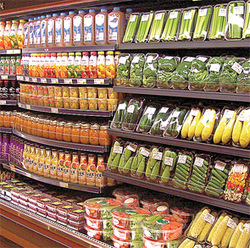
by Ron Pelger | March 20, 2014
This story originally appeared in The Produce News and is reprinted with permission. All rights reserved.
An industry friend called me not long ago and told me about his recent store visits. He explained that his trip took him to seven supermarkets and every one of the produce departments looked the same. They all had the usual displays of bananas, lettuce and apples. He claimed that he did not see anything new or different.
This conversation got me thinking. If he didn’t see a difference, what did the customers see? What variations do departments need to make people stop in their tracks and draw their attention?A cut fruit and juice section is one way that a retailer can differentiate itself from its competition.
In this day and age, retailers need to differentiate their produce departments from their competition. While most departments have a nice appearance, they are all too common with the same displays, same advertising, same product line and the same basic operating programs. The problem with this similarity is it doesn’t reflect any distinctive personality.
Shoppers rarely take note of the displays around them. That’s mainly due to the fact that the produce departments are all too generic for them. When nothing is new, different or exciting, a shopper’s focus becomes blurry. They tend to just pick up a few basic everyday items and make their way to the registers. They are not motivated to make extra purchases.
Display presentation has always been the main reason for drawing customers into the produce department. The way produce looks is oftentimes more important than the items being sold. Produce merchandising is an art and a science.
In order to capture a customer’s attention these days, the produce department must provide a great shopping experience. People admire uniqueness and something that pops out at them while walking through the department. That uniqueness must grab a shopper’s attentiveness in a split second. Once his or her senses are captivated, they can become easily influenced into making additional purchases. That uniqueness will also stick in their minds and turn them into devoted customers.
What characteristic do you have that is different from your competition? Is it unique? What is it that you want your customers to see in a split second?
Research studies have shown that 64 percent of purchase decisions made by shoppers occur while they are inside the stores. This means that something triggered customers to buy specific items right on the spot. Most had no preplanned intentions of making those purchases. Those were impulse sales generated by displays that were extraordinary.
Produce departments can capture the attention of customers with specialized displays that are also unique. These displays are called “Signature Sections.”
A Signature Section is defined as a prominent niche that identifies an exceptional characteristic similar to a brand. These sections are special classification “departments within the produce department.”
Types of Signature Sections include mushrooms, peppers, tomatoes, fresh-cut fruit, fresh-cut vegetables, value-added salads, fresh herbs and fruit baskets. These sections are similar to family groupings of items, except they are enriched with visual elements of enhancement. They are driven by the number of varieties and choices that attract customers to the displays.
In produce, the differences between competitors comes down to who has the edge in the marketing area. Find a way to differentiate your produce from your competition. Signature Sections can give you that edge with niche merchandising vs. the common mainstream. The biggest challenge today is to define the niche that your produce operation does better than the competition.
The main components of Signature Sections are:
Make merchandising the focal point
Create state-of-the-art displays, showcase the product items within the overall display window, and use superior workmanship.
Go all out
Offer every available variety and choices in the section; carry all sizes of packages and bulk. For example, display 15 to 18 different pepper choices rather than just eight, and present up to 25 various types of tomatoes in bulk and packages. Handle anything and everything your competition does not carry.
Attract with colors
Produce is known for its dramatic colors, and the use of blended colors can be very effective in capturing customer attention.
Communicate persuasively
Post overhead descriptive signs above sections for identification and use informative selling signs that educate shoppers about the product.
These should be exceptional sections that are vibrant and picturesque. Make sure to frame your Signature Sections like masterpiece paintings hanging in a museum expressing uniqueness. When you do this, people will remember you as being different rather than common like your competition.
Ron Pelger is the president and CEO of RonProCon, a consulting firm for the produce industry, and the chairperson of FreshXperts LLC, a consortium of produce professionals. He can be reached by phone at 775/853-7056 or by email at[email protected], or check his details on freshxperts.com for more information.
This story originally appeared in The Produce News and is reprinted with permission. All rights reserved.
An industry friend called me not long ago and told me about his recent store visits. He explained that his trip took him to seven supermarkets and every one of the produce departments looked the same. They all had the usual displays of bananas, lettuce and apples. He claimed that he did not see anything new or different.
This conversation got me thinking. If he didn’t see a difference, what did the customers see? What variations do departments need to make people stop in their tracks and draw their attention?A cut fruit and juice section is one way that a retailer can differentiate itself from its competition.
In this day and age, retailers need to differentiate their produce departments from their competition. While most departments have a nice appearance, they are all too common with the same displays, same advertising, same product line and the same basic operating programs. The problem with this similarity is it doesn’t reflect any distinctive personality.
Shoppers rarely take note of the displays around them. That’s mainly due to the fact that the produce departments are all too generic for them. When nothing is new, different or exciting, a shopper’s focus becomes blurry. They tend to just pick up a few basic everyday items and make their way to the registers. They are not motivated to make extra purchases.
Display presentation has always been the main reason for drawing customers into the produce department. The way produce looks is oftentimes more important than the items being sold. Produce merchandising is an art and a science.
In order to capture a customer’s attention these days, the produce department must provide a great shopping experience. People admire uniqueness and something that pops out at them while walking through the department. That uniqueness must grab a shopper’s attentiveness in a split second. Once his or her senses are captivated, they can become easily influenced into making additional purchases. That uniqueness will also stick in their minds and turn them into devoted customers.
What characteristic do you have that is different from your competition? Is it unique? What is it that you want your customers to see in a split second?
Research studies have shown that 64 percent of purchase decisions made by shoppers occur while they are inside the stores. This means that something triggered customers to buy specific items right on the spot. Most had no preplanned intentions of making those purchases. Those were impulse sales generated by displays that were extraordinary.
Produce departments can capture the attention of customers with specialized displays that are also unique. These displays are called “Signature Sections.”
A Signature Section is defined as a prominent niche that identifies an exceptional characteristic similar to a brand. These sections are special classification “departments within the produce department.”
Types of Signature Sections include mushrooms, peppers, tomatoes, fresh-cut fruit, fresh-cut vegetables, value-added salads, fresh herbs and fruit baskets. These sections are similar to family groupings of items, except they are enriched with visual elements of enhancement. They are driven by the number of varieties and choices that attract customers to the displays.
In produce, the differences between competitors comes down to who has the edge in the marketing area. Find a way to differentiate your produce from your competition. Signature Sections can give you that edge with niche merchandising vs. the common mainstream. The biggest challenge today is to define the niche that your produce operation does better than the competition.
The main components of Signature Sections are:
Make merchandising the focal point
Create state-of-the-art displays, showcase the product items within the overall display window, and use superior workmanship.
Go all out
Offer every available variety and choices in the section; carry all sizes of packages and bulk. For example, display 15 to 18 different pepper choices rather than just eight, and present up to 25 various types of tomatoes in bulk and packages. Handle anything and everything your competition does not carry.
Attract with colors
Produce is known for its dramatic colors, and the use of blended colors can be very effective in capturing customer attention.
Communicate persuasively
Post overhead descriptive signs above sections for identification and use informative selling signs that educate shoppers about the product.
These should be exceptional sections that are vibrant and picturesque. Make sure to frame your Signature Sections like masterpiece paintings hanging in a museum expressing uniqueness. When you do this, people will remember you as being different rather than common like your competition.
Ron Pelger is the president and CEO of RonProCon, a consulting firm for the produce industry, and the chairperson of FreshXperts LLC, a consortium of produce professionals. He can be reached by phone at 775/853-7056 or by email at[email protected], or check his details on freshxperts.com for more information.


 RSS Feed
RSS Feed
